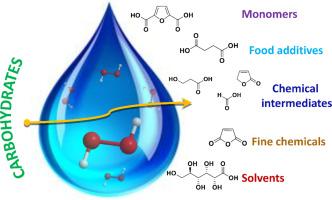过氧化氢作为一种绿色氧化剂,可将生物可再生碳水化合物转化为具有工业意义的有机化学品
IF 5.2
2区 化学
Q2 CHEMISTRY, PHYSICAL
引用次数: 0
摘要
生物炼制过程继续寻求可持续的试剂有机转化,特别是氧化还原反应。采用水溶液过氧化氢(AQHP)的液相氧化反应不需要气体氧化剂的超压,需要相对温和的条件,并且产生水和氧作为无害的副产物。AQHP越来越多地用于生物质增值途径,通常在合适的均相或非均相催化剂的存在下,以更快的动力学和更好的选择性。这项工作给出了使用AQHP作为绿色氧化剂在化学催化和化学酶条件下将碳水化合物或碳水化合物衍生的化学中间体转化为具有工业意义的有机化学品的最新进展。机制的见解,选择性和可扩展性的碳水化合物和碳水化合物衍生的化学构建块涉及AQHP氧化反应的阐述。强调了使用AQHP作为绿色氧化剂的以碳水化合物为中心的生物炼制工艺的前景和挑战。本文章由计算机程序翻译,如有差异,请以英文原文为准。

Hydrogen peroxide as a green oxidant for transforming biorenewable carbohydrates into organic chemicals of industrial significance
Biorefinery processes continue to seek sustainable reagents for organic transformations, especially for redox reactions. The liquid-phase oxidation reactions employing aqueous hydrogen peroxide (AQHP) do not necessitate an overpressure of gaseous oxidants, require relatively mild conditions, and produce water and oxygen as innocuous byproducts. AQHP is increasingly used in biomass value-addition pathways, often in the presence of a suitable homogeneous or heterogeneous catalyst, for faster kinetics and improved selectivity. This work gives an account of the recent developments in using AQHP as a green oxidant to convert carbohydrates or carbohydrate-derived chemical intermediates into organic chemicals of industrial significance under chemocatalytic and chemoenzymatic conditions. Mechanistic insights, selectivity, and scalability of the oxidation reactions of carbohydrates and carbohydrate-derived chemical building blocks involving AQHP have been elaborated. The prospects and challenges associated with carbohydrate-centric biorefinery processes using AQHP as a green oxidant have been highlighted.
求助全文
通过发布文献求助,成功后即可免费获取论文全文。
去求助
来源期刊

Journal of Molecular Liquids
化学-物理:原子、分子和化学物理
CiteScore
10.30
自引率
16.70%
发文量
2597
审稿时长
78 days
期刊介绍:
The journal includes papers in the following areas:
– Simple organic liquids and mixtures
– Ionic liquids
– Surfactant solutions (including micelles and vesicles) and liquid interfaces
– Colloidal solutions and nanoparticles
– Thermotropic and lyotropic liquid crystals
– Ferrofluids
– Water, aqueous solutions and other hydrogen-bonded liquids
– Lubricants, polymer solutions and melts
– Molten metals and salts
– Phase transitions and critical phenomena in liquids and confined fluids
– Self assembly in complex liquids.– Biomolecules in solution
The emphasis is on the molecular (or microscopic) understanding of particular liquids or liquid systems, especially concerning structure, dynamics and intermolecular forces. The experimental techniques used may include:
– Conventional spectroscopy (mid-IR and far-IR, Raman, NMR, etc.)
– Non-linear optics and time resolved spectroscopy (psec, fsec, asec, ISRS, etc.)
– Light scattering (Rayleigh, Brillouin, PCS, etc.)
– Dielectric relaxation
– X-ray and neutron scattering and diffraction.
Experimental studies, computer simulations (MD or MC) and analytical theory will be considered for publication; papers just reporting experimental results that do not contribute to the understanding of the fundamentals of molecular and ionic liquids will not be accepted. Only papers of a non-routine nature and advancing the field will be considered for publication.
 求助内容:
求助内容: 应助结果提醒方式:
应助结果提醒方式:


